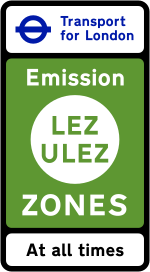Ultra Low Emission Zone
The zone has reduced the number of non-compliant cars on the road and has averted an amount of toxic air pollution equivalent to that emitted by London's airports combined.
Although planned and developed across different governing London political parties, the ULEZ has become politicised, with criticisms regarding its effectiveness and value reported on.
Sadiq Khan, Johnson's successor, introduced an emissions surcharge, called the Toxicity Charge or "T-Charge", for non-compliant vehicles from 2017.
[10] The ULEZ was expanded on 29 August 2023 to cover all 32 London boroughs, bringing an additional five million people into the zone.
It covers most of Greater London, with minor deviations to allow diversionary routes and facilities to turn around without entering the zone.
The original scheme offered up to £7,000 compensation for a car or van which had been operating in the congestion zone, plus up to £2,500 if this was replaced by an electric vehicle.
[21] When ULEZ was expanded beyond the congestion charge zone, the compensation was reduced to £2,000 for cars with a limit for the number of vans and initially £15,000 for heavy vehicles.
[25][26] It stated that there has been a longer-term downward trend in London's air pollution levels and argued that the ULEZ on its own is not an effective strategy.
[25][27] The Greater London Authority had been funding other work at the College since July 2020, including the Environmental Research Group.
[31] The number of non-compliant vehicles entering the zone each day dropped from 35,578, in March 2019, to 26,195 in April of the same year, after the charge was introduced.
[37] In Outer London, the percentage of compliant vehicles rose from 85% in May 2022 when the consultation for expansion was announced, to 90.9% in June 2023 and further jumped to 95.2% in September 2023 following the beginning of charging.
Writing in 2019, the BBC's transport correspondent Tom Edwards described the Ultra Low Emission Zone as "one of the most radical anti-pollution policies in the world".
[42] A poll in April 2019 by YouGov found that 72% of Londoners supported using emissions charging to tackle both air pollution and congestion.
[44] Ross Clark, writing in The Spectator, argued in 2022 the expansion would disproportionately impact poorer Londoners, who were more likely to own an older, non-compliant vehicle that would be subject to the daily charge.
Two further grounds concerned the scrappage scheme, "whether the mayor properly considered the previous "buffer zone" approach as a material consideration" and "irrationality due to uncertainty and inadequate consultation".
[57] On 4 October 2023, it was reported that Laurence Fox had been arrested by police on suspicion of conspiring to commit criminal damage to ULEZ cameras.





